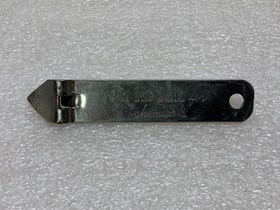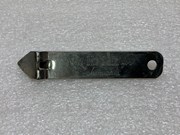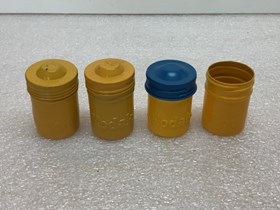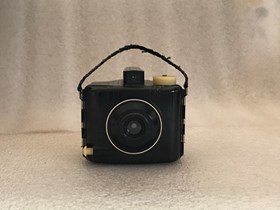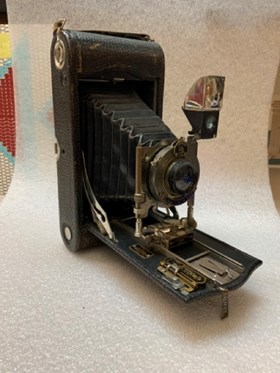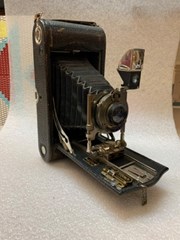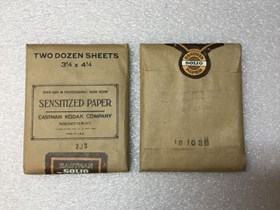Narrow Results By
- Date
- n.d.
- Material
- metal
- Catalogue Number
- 104.19.0178
- Description
- A small metal can opener with a sharp pointed end for opening cans and a small hole for hanging or attaching to a key ring at the other end. The top side is stamped with “It’s Kodak for chemicals”. The reverse is stamped with “CM 1 APP MOD VAUGHAN USA 55”
1 image
- Title
- Can Opener
- Date
- n.d.
- Material
- metal
- Dimensions
- 2.0 x 2.0 x 10.0 cm
- Description
- A small metal can opener with a sharp pointed end for opening cans and a small hole for hanging or attaching to a key ring at the other end. The top side is stamped with “It’s Kodak for chemicals”. The reverse is stamped with “CM 1 APP MOD VAUGHAN USA 55”
- Subject
- Whyte home
- drinking
- beer
- tools
- Kodak
- Credit
- Gift of Catharine Robb Whyte, O. C., Banff, 1979
- Catalogue Number
- 104.19.0178
Images
This material is presented as originally created; it may contain outdated cultural descriptions and
potentially offensive content.
Read more.
- Date
- n.d.
- Material
- metal
- Catalogue Number
- 104.41.0013 a-d
- Description
- 4 metal Kodak film canisters. Canisters are yellow with “KODAK” embossed on the sides and screw caps. (b) has “C630” written in grease pencil on the base (c) has a blue cap and (d) is missing its cap.
1 image
- Title
- Film Canister
- Date
- n.d.
- Material
- metal
- Dimensions
- 5.4 x 3.1 cm
- Description
- 4 metal Kodak film canisters. Canisters are yellow with “KODAK” embossed on the sides and screw caps. (b) has “C630” written in grease pencil on the base (c) has a blue cap and (d) is missing its cap.
- Subject
- Whyte home
- photography
- Kodak
- Film
- Credit
- Gift of Catharine Robb Whyte, O. C., Banff, 1979
- Catalogue Number
- 104.41.0013 a-d
Images
This material is presented as originally created; it may contain outdated cultural descriptions and
potentially offensive content.
Read more.
Darkroom Timer
https://archives.whyte.org/en/permalink/artifact104.41.0018
- Date
- n.d.
- Material
- metal; plastic
- Catalogue Number
- 104.41.0018
- Description
- Small red stand up timer, rectangular metal base, round timer body on a vertical swivel, metal ring around clock face reads: “START / STOP” with lever in between. Timer has marks for intervals from 5 to 60. Face reads: “KODAK TIMER; EASTMAN KODAK CO.; ROCHESTER, N.Y”. Back has a wind up key and sti…
1 image
- Title
- Darkroom Timer
- Date
- n.d.
- Material
- metal; plastic
- Dimensions
- 13.0 x 12.0 cm
- Description
- Small red stand up timer, rectangular metal base, round timer body on a vertical swivel, metal ring around clock face reads: “START / STOP” with lever in between. Timer has marks for intervals from 5 to 60. Face reads: “KODAK TIMER; EASTMAN KODAK CO.; ROCHESTER, N.Y”. Back has a wind up key and sticker that reads: “SOLE DISTRIBUTOR IN CANADA; CANADIAN KODAK CO., LIMITED; TORONTO”.
- Subject
- Whyte home, photography, Kodak
- Credit
- Gift of Catharine Robb Whyte, O. C., Banff, 1979
- Catalogue Number
- 104.41.0018
Images
This material is presented as originally created; it may contain outdated cultural descriptions and
potentially offensive content.
Read more.
Darkroom Timer
https://archives.whyte.org/en/permalink/artifact104.41.0019
- Date
- n.d.
- Material
- metal; plastic
- Catalogue Number
- 104.41.0019
- Description
- Small silver square timer with rectangular silver base. Timer face is black with yellowing clock that has 0 to 25 second intervals and reads: “MADE IN U.S.A FOR EASTMAN KODAK COMPANY ROCHESTER N.Y; KODAK INTERVAL TIMER”. The most prominent clock hand has two small metal protrusions, not including b…
1 image
- Title
- Darkroom Timer
- Date
- n.d.
- Material
- metal; plastic
- Dimensions
- 10.8 x 12.0 cm
- Description
- Small silver square timer with rectangular silver base. Timer face is black with yellowing clock that has 0 to 25 second intervals and reads: “MADE IN U.S.A FOR EASTMAN KODAK COMPANY ROCHESTER N.Y; KODAK INTERVAL TIMER”. The most prominent clock hand has two small metal protrusions, not including bolt. Back has key shaped hole and sticker that reads: “SOLE IMPORTER INTO CANADA; CANADIAN KODAK CO., LIMITED; TORONTO”. Bottom of timer reads: “4414”.
- Subject
- Whyte home, photography, Kodak
- Credit
- Gift of Catharine Robb Whyte, O. C., Banff, 1979
- Catalogue Number
- 104.41.0019
Images
This material is presented as originally created; it may contain outdated cultural descriptions and
potentially offensive content.
Read more.
- Date
- n.d.
- Material
- plastic
- Catalogue Number
- 104.41.0020
- Description
- Height including strap: 10.4 cmSmall black cube camera with parallel line design running from front to back. On top is a long rectangular eyepiece and yellow shutter dial. Front of camera is decorated with a yellow circle around the lens, text around lens reads: “BABY BROWNIE SPECIAL”. On the front…
1 image
- Title
- Film Camera
- Date
- n.d.
- Material
- plastic
- Dimensions
- 8.8 x 8.5 cm
- Description
- Height including strap: 10.4 cmSmall black cube camera with parallel line design running from front to back. On top is a long rectangular eyepiece and yellow shutter dial. Front of camera is decorated with a yellow circle around the lens, text around lens reads: “BABY BROWNIE SPECIAL”. On the front bottom left corner is a yellow mushroom-shaped button. On either side is a small length of metal that secures the black leather strap to camera. On the back is a red ring with plastic inset, below it reads: “MADE IN U.S.A BY EASTMAN KODAK CO. ROCHESTER N.Y”.
- Subject
- Whyte home, photography, Kodak
- Credit
- Gift of Catharine Robb Whyte, O. C., Banff, 1979
- Catalogue Number
- 104.41.0020
Images
This material is presented as originally created; it may contain outdated cultural descriptions and
potentially offensive content.
Read more.
- Date
- 1920 – 1940
- Material
- metal; leather; plastic; celluloid
- Catalogue Number
- 104.41.0086 a-c
- Description
- Three black metal and leather “GRAFLEX CUT FILM MAGAZINE,” used to store individual celluloid negatives mounted into individual sleeves housed inside the main body. Access to the main body is possible by removing the the thin back panel with a leather strap that slides up alongside the leather bag …
1 image
- Title
- Film Magazines
- Date
- 1920 – 1940
- Material
- metal; leather; plastic; celluloid
- Dimensions
- 11.0 x 3.5 x 6.5 cm
- Description
- Three black metal and leather “GRAFLEX CUT FILM MAGAZINE,” used to store individual celluloid negatives mounted into individual sleeves housed inside the main body. Access to the main body is possible by removing the the thin back panel with a leather strap that slides up alongside the leather bag as well by pressing a button on the edge opposite the leather bag, allowing the front panel to pop open. On the front panel that can pop off is a small peephole accessible by a spring-hinged cover. Two of the magazines, marked with a red and a white strip of fabric, have the front panels taped closed with a small piece of masking tape.The three magazines are meant for different kinds of film. The one marked with a small strip of green fabric is meant for “KODAK EXTACOLOR Professional Type S (Short Exposure),” the one marked with the red fabric is meant for “KODAK EKTACHROME Film 6116, Type B (Process E-3),” and the one marked with the white fabric is meant for “KODAK TRI-X PAN SHEET FILM (ESTAR Thick Base).” The individual slides housed inside the magazine with the green fabric may have unprocessed fogged negatives still in them.
- Subject
- Nicholas Morant
- photography
- Kodak
- film photography
- photo developing
- Canadian Pacific Railway
- Credit
- Gift of Nicholas Morant, Banff, 2006
- Catalogue Number
- 104.41.0086 a-c
Images
This material is presented as originally created; it may contain outdated cultural descriptions and
potentially offensive content.
Read more.
Brownie Camera
https://archives.whyte.org/en/permalink/artifact104.41.0190
- Date
- 1931 – 1931
- Material
- cardboard; metal; leather; glass;
- Catalogue Number
- 104.41.0190
- Description
- Black hard leather-sided No. 2 Brownie camera in its original packaging. Camera has a leather handle on the top, along with one viewfinder - a second viewfinder is on the adjacent side, which also as a round metal crank. The back panel of the camera can be removed in order to access the film compar…
1 image
- Title
- Brownie Camera
- Date
- 1931 – 1931
- Material
- cardboard; metal; leather; glass;
- Dimensions
- 10.8 x 8.8 x 14.0 cm
- Description
- Black hard leather-sided No. 2 Brownie camera in its original packaging. Camera has a leather handle on the top, along with one viewfinder - a second viewfinder is on the adjacent side, which also as a round metal crank. The back panel of the camera can be removed in order to access the film compartment. The cardboard box folds together and is not held with adhesives - except where the lip of the lid fit against the front panel.
- Credit
- Gift of Robert Crosby Family, Banff, 1998
- Catalogue Number
- 104.41.0190
Images
This material is presented as originally created; it may contain outdated cultural descriptions and
potentially offensive content.
Read more.
- Date
- 1914 – 1917
- Material
- leather; metal; glass;
- Catalogue Number
- 104.41.0193
- Description
- Black hard-sided leather No. 3-A Autographic Kodak Model C folding camera. The front panel is released by pressing a small round metal button on the narrow bottom edge [the bottom of the camera is noted by the presence of a threaded hole where a tripod could be mounted] and has a small rectangular …
1 image
- Title
- Kodak Camera
- Date
- 1914 – 1917
- Material
- leather; metal; glass;
- Dimensions
- 5.0 x 12.0 x 25.0 cm
- Description
- Black hard-sided leather No. 3-A Autographic Kodak Model C folding camera. The front panel is released by pressing a small round metal button on the narrow bottom edge [the bottom of the camera is noted by the presence of a threaded hole where a tripod could be mounted] and has a small rectangular metal foot with “Kodak” engraved in decorative writing that keeps the camera propped up. The lens mechanism slides out on tracks with soft black leather bellows behind it and a viewfinder with a pop-up cover attached to the top right-hand corner. The back panel of the camera pops off by pressing two metal clasps on both short sides and can house a roll of film. When the camera is open, on the top is a leather strap with a faded “Kodak” embossed on it.
- Subject
- Crosby family
- Abegweit
- cameras
- photography
- Kodak;
- Credit
- Gift of Robert Crosby Family, Banff, 1998
- Catalogue Number
- 104.41.0193
Images
This material is presented as originally created; it may contain outdated cultural descriptions and
potentially offensive content.
Read more.
- Date
- 1905 – 1924
- Material
- paper;
- Catalogue Number
- 104.41.0200 a,b
- Description
- Two packages of 3 1/4 x 4 1/4 Kodak Sensitized Paper, also known as Solio Paper, in brown paper wrapping - unopened. Details of the contents stamped on the front in black ink, and the packages are held closed with a brown, orange, and white “EASTMAN SOLIO PAPER” sticker that wraps over the bottom e…
1 image
- Title
- Photo Paper
- Date
- 1905 – 1924
- Material
- paper;
- Dimensions
- 0.9 x 9.4 x 11.8 cm
- Description
- Two packages of 3 1/4 x 4 1/4 Kodak Sensitized Paper, also known as Solio Paper, in brown paper wrapping - unopened. Details of the contents stamped on the front in black ink, and the packages are held closed with a brown, orange, and white “EASTMAN SOLIO PAPER” sticker that wraps over the bottom edge from front to back. Faded stamps on the backs are mostly illegible, but the expiration date of “MAY 15 1924” is visible.
- Credit
- Gift of Robert Crosby Family, Banff, 1998
- Catalogue Number
- 104.41.0200 a,b
Images
This material is presented as originally created; it may contain outdated cultural descriptions and
potentially offensive content.
Read more.
- Date
- 1908 – 1908
- Material
- cardboard;
- Catalogue Number
- 104.41.0202
- Description
- Empty cardboard box of Kokak Solio Toning and Fixing Powder cartridges with manufacturer and product details printed throughout the white box in red and black. Toning powders were chemical compounds designed to react with the emulsion layers of positive photographs that altered the tone (or colour)…
1 image
- Title
- Solio Powder
- Date
- 1908 – 1908
- Material
- cardboard;
- Dimensions
- 2.2 x 10.2 x 8.8 cm
- Description
- Empty cardboard box of Kokak Solio Toning and Fixing Powder cartridges with manufacturer and product details printed throughout the white box in red and black. Toning powders were chemical compounds designed to react with the emulsion layers of positive photographs that altered the tone (or colour) of the image, usually turning a standard black-and-white image into warmer shades of red, brown, and/or purple - sepia is a very common tone. Additionally, toning powders could be combined with a fixing agent that stabilized the emulsion layer to prevent it breaking down or fading, flaking off, or otherwise ruining the image as it set.
- Subject
- Crosby family
- Abegweit
- photography
- photographic equipment
- chemicals
- photograph development
- Kodak;
- Credit
- Gift of Robert Crosby Family, Banff, 1998
- Catalogue Number
- 104.41.0202
Images
This material is presented as originally created; it may contain outdated cultural descriptions and
potentially offensive content.
Read more.

